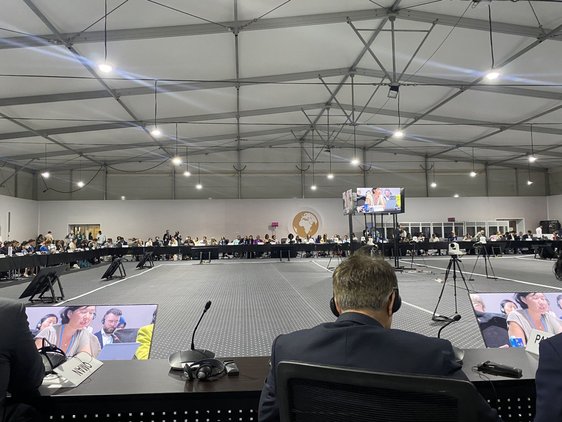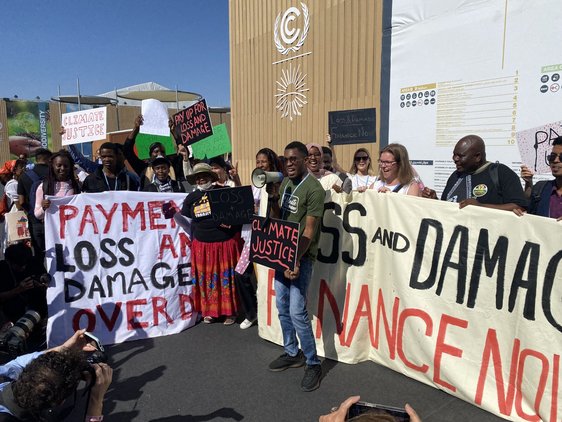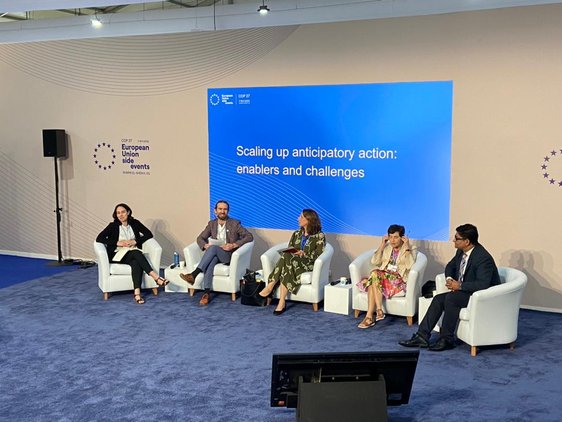COP27 and anticipatory action: encouraging progress but much work ahead
This year’s COP in Sharm El-Sheikh was a special one – some might even say historic. While there was little, if any, progress on curbing emissions and adapting to climate change, it was a success from an anticipatory action perspective, with several important outcomes for our community.
Establishment of a loss and damage fund
Loss and damage was the key topic at the conference. Not only was financing for this on the COP agenda for the first time, but world leaders also agreed to establish new funding arrangements – including a dedicated loss and damage fund – to assist countries from the Global South, especially “particularly vulnerable countries”, to cope with the adverse effects of climate change.
Countries from the Global South, and Small Island Development States in particular, have been demanding such a fund for nearly 30 years. These demands were finally met when the EU shifted its position and came up with a last-minute proposal, which in turn led to the USA relenting and agreeing to the fund, rather than remaining isolated in opposition. This gave a belated impetus to the stalling negotiations and paved the way for an agreement to be reached early on Sunday, 20 November – two days after the planned close of the world’s biggest conference.
The hard work isn’t over, though; indeed, it will intensify over the next 12 months. A 24-member Transitional Committee was created to work out the details of the modalities for putting the loss and damage fund into operation, and to identify where the funding will come from. This process will include two workshops in 2023, a synthesis report on existing funding arrangements and innovative sources relevant to addressing loss and damage (also in 2023), as well as a call for submissions by 15 February 2023. UN agencies, intergovernmental organizations and financial institutions have been invited to submit ideas on how they might enhance access to, and/or the speed, scope and scale of, the finance available for addressing loss and damage. This includes potential limitations and barriers, and options for addressing them.
The anticipatory action community can bring its expertise to this debate. As highlighted in the Anticipation Hub’s recent policy brief, anticipatory action can help to minimize climate-related losses and damages, and there are already several humanitarian funds out there that provide support for implementing anticipatory action (e.g., IFRC’s DREF, OCHA’s CERF, the Start Fund). Lessons from these operations – including challenges to consider when designing a loss and damage fund (e.g., financing principles, triggers to activate the funds, absorption capacities, flexibility, layering of financing tools, how to channel funds to local actors), the shortcomings (e.g., charity/donation basis, underfunding, eligibility) and ideas to overcome these (e.g., reinsurance, broadening the donor base, simplified early action protocols) – might be valuable for the climate community. Such insights can also help to ensure that any new loss and damage arrangement will complement existing humanitarian funds and ensure they are more predictable than traditional humanitarian funding.
Putting the Santiago Network on loss and damage into operation
Negotiators at COP27 agreed on the mechanisms to operationalize the Santiago Network on loss and damage. This was established at COP25 in Madrid with the objective of “catalysing technical assistance of relevant organisations, bodies, networks and experts, for the implementation of relevant approaches for averting, minimise and addressing loss and damage at the local, national and regional level, in developing countries that are particularly vulnerable to the adverse effects of climate change”.
At COP26 in Glasgow, parties agreed on the six functions of the Santiago Network. These include, among others: assisting in identifying and communicating technical assistance needs and priorities; identifying relevant technical assistance; and actively connecting those seeking technical assistance with the organizations, bodies, networks and experts best suited to provide such assistance.
This year’s focus was the institutional arrangements to deliver on these functions. Ahead of the negotiations, many parties and other stakeholders provided innovative thoughts and ideas on the institutional architectures that would enable the Santiago Network to deliver its functions effectively. For example, the Anticipation Hub, the Anticipatory Action Focus Task Force and REAP made suggestions on its governance structure and the support that the network can deliver. A key outcome of COP27 was the decision that the network will be governed by a secretariat and an advisory board – the latter being a key demand of developing countries.
Representatives of the groups most affected by loss and damage, including women, youth and indigenous people, will be part of this advisory board. This will hopefully ensure that it delivers solutions that are grounded in local needs. Once the host organization for the secretariat has been identified, the Santiago Network should be fully operational. A critical issue, however, is that little finance has been committed so far for its operation or the delivery of technical assistance. There is a risk that it will be short of cash and therefore unable to operate effectively.
The advisory board must agree on its operating principles and the membership criteria for the organizations, bodies, networks (including the Anticipation Hub) and experts that will constitute this network. It will be crucial for the anticipatory action community to engage with this board and ensure that anticipatory action is part of the secretariat’s work plan, at both the programming and financing levels. This will require highlighting the investment needed to bring anticipatory action to scale at national and global levels, as well as the work needed to make anticipatory action an integral part of disaster risk management, climate adaptation – and, perhaps at some point in the future, national loss and damage frameworks.

Loss and Damage negotations in Sharm El- Sheik © German Red Cross

Plenary Session at COP27 © German Red Cross

Protesters calling industralized countries to pay for losses and damage © German Red Cross

Anticipation Hub session at the EU Pavilion on how to bring anticipatory action to scale © Zambia RC

Loss and Damage negotations in Sharm El- Sheik © German Red Cross
Plenary Session at COP27 © German Red Cross
Protesters calling industralized countries to pay for losses and damage © German Red Cross
Anticipation Hub session at the EU Pavilion on how to bring anticipatory action to scale © Zambia RC
The Early Warning for All initiative
COP27 saw the formal launch of the Early Warnings for All initiative, which aims to ensure that every human has access to early warnings by 2027. The Executive Action Plan, unveiled at COP27, sets out clear steps to achieve this goal and calls for initial new targeted investments of 3.1 billion US dollars over five years. This action plan was drawn up by the World Meteorological Organization (WMO) and its partners, and is supported by a joint statement signed by 50 countries. The estimated investment needs will be used to advance four key pillars:
- disaster risk knowledge (374 million US dollars) to systematically collect data and undertake risk assessments on hazards and vulnerabilities
- observations and forecasting (1.18 billion US dollars) to develop hazard monitoring and early warning services
- preparedness and response (1 billion US dollars) to build national and community response capabilities
- dissemination and communication (550 million US dollars) to communicate risk information so it reaches all those who need it, and is understandable and usable.
The action plan identifies priority actions for advancing these pillars, building on existing frameworks, initiatives and mechanisms. A range of actors from the anticipatory action community have been involved in the planning process (including the IFRC, WFP, FAO, OCHA, REAP) and some of these are co-leading or supporting pillars. Pivotal to its success will be ensuring that as much focus is put on bridging the pillars of this action plan, as is place on each individual pillar. Leveraging the power of existing coordination, collaboration and exchange platforms and mobilizing additional partners from the anticipatory action community to enhance the sustainability across the four pillars, will be critical to realizing this ambitious plan.
The next step will be moving from planning to implementation. To this end, WMO will create an ‘Early Warnings for All’ governing board, co-chaired by WMO and UNDRR. It will also organize, among other activities, a multistakeholder forum to consult with a wide group of partners and to refine the action plan. This forum will provide an opportunity for interested organizations within the anticipatory action community to support the initiative and shape its implementation.
The Global Shield Against Climate Risks
Through the UNFCCC process, the G20 and the V20 launched the Global Shield Against Climate Risks. This aims to provide, and ease access to, funds for developing and scaling up climate and disaster risk-financing instruments for governments, communities, businesses and households in countries facing an increasing risk of loss and damage. It covers a broad range of instruments, such as insurance or designated disaster reserves, but also anticipatory action and forecast-based financing. It will initially be rolled out in seven ‘pathfinder countries’ and then gradually expanded to others.
The basis for this instrument is the plans that a country draws up after analysing its own climate risks and protection gaps. Where are the biggest risks? Which protection and preparedness systems are needed to mitigate these risks efficiently? What can we scale up and what do we need to develop? With this plan, a country can approach the Global Shield secretariat which, together with its partners, will then support and guide the country towards the right financing fund: the Global Shield Solution Fund, the Global Shield Financing Facility, or the CVF-V20 Multi-Donor Trust Fund.
The Global Shield is an important step towards improving the coordination of the fragmented global landscape for disaster risk financing and the proliferation of actors working in this space. The key will be to ensure an equal balance in the distribution of funds between countries, but also between instruments; in other words, to ensure that they are grounded in local needs and not in vested interests. A number of countries and NGOs have already criticized the Global Shield for indications it would focus too heavily on insurance and divert funds from efforts to address loss and damage under the UNFCCC, including under the Santiago Network. While it is true that most financial pledges made towards loss and damage at COP27 – some 77 per cent - went to the Global Shield, it remains to be seen if it is too focused on insurance. Encouragingly, the concept note clearly delineates the role of anticipatory action and other tools (e.g., social protection systems).
A lot of details still need to be fleshed out in the near future, such as how the cross-sectoral in-country dialogues will be organized. However, at this point the Global Shield offers many possibilities for the anticipatory action community, for example engaging with the in-country dialogues to identify needs, gaps and options, or – considering that humanitarian organizations are eligible for funding – as implementers or developers of anticipatory action. There is also scope for getting involved in the technical work; for example, by sharing experiences and providing guidance, or in the governance structure to ensure the Global Shield does indeed look beyond insurance.
A strong focus on thematic areas relevant to anticipatory action
Anticipatory action was firmly on the agenda across the side events held at COP27. The event calendar set up by REAP and the Anticipation Hub recorded more than 50 relevant events. The Anticipation Hub was also involved in two side events held in the EU Pavilion, ‘Scaling up anticipatory action: enablers and challenges’ and ‘Anticipatory action – at the nexus between humanitarian, development, peace and climate action’ (recordings of both are available here).
The language around the role and potential of early warning systems was even taken up in the text of the cover decision – the all-important political commitments agreed by all nations – and as part of the informal loss and damage negotiations. The cover decision, known officially as the Sharm-El-Sheik Implementation Plan, highlights not only the gaps in coverage in early warning systems, but also the role that “useful and actionable climate information can play”. It also makes a direct reference to the Early Warning for All initiative.
However, while this is a positive development, the role of anticipatory action plans and community engagement linked to early warning systems remains a gap in the framing of the text. This is an area for the anticipatory action community to engage around on the road to COP28 – especially with the limited overall progress on curbing emissions, which will result into more loss and damage.
What is more, multilateral development banks and international financial institutions have been called upon by the cover decision to reform their practices and priorities to address the global climate emergency. This call to scale up and simplify access to climate finance for countries that need them was unexpected. But it is not clear what this means in practice; for example, if this will lead to more grant-based finance, or if it will remain as concessional loans. The anticipatory action community should call on those actors to implement the necessary changes in governance to enable and increase the share of direct access modalities (e.g., by easing accreditation processes) that better serve local needs.
Conclusions
The political space on loss and damage shifted at COP27. This was hailed by many as great progress, albeit too slow when compared to needs. And, as mentioned, the real hard work begins now. While leaders were meeting in Sharm-El-Sheik, the IFRC’s risk watch system put out alerts for some 14 floods in Africa, 18 in the Americas, 35 in Asia-Pacific, five in the EU and two in the Middle East and North Africa region. During this same period, four named tropical storms threatened destruction, while wildfires ripped through communities in 10 countries, damaging more than 10,000 hectares. And all the while communities in Africa, Afghanistan and elsewhere continue to grapple with food insecurity and other alarming, compounding crises. In short – there is no time to waste. Let’s move immediately from words to action.
This op-ed was written by Dr Nikolas Scherer, manager for policy and advocacy on anticipation and disaster risk financing, Anticipation Hub.
